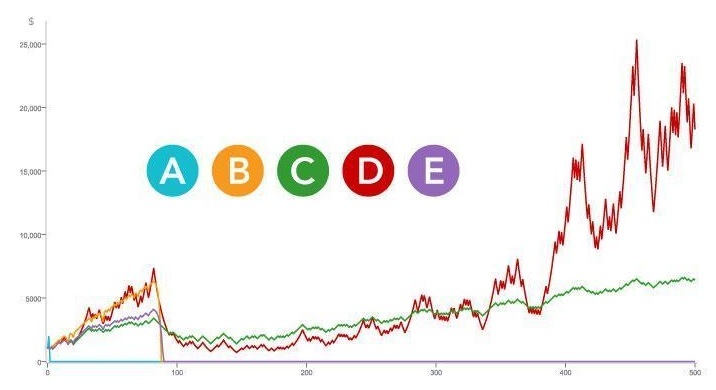Staking Method Explained

It is a generally accepted assumption that in order to be profitable at sports betting one needs to have any knowledge about the sport in question as the two most important prerequisites.
Such assumption is not far from the truth, to be honest, but in order to be considered a successful punter, one first needs a fully developed and well-disciplined staking method which will allow you the freedom to bet on the long run without fearing the worst – going broke.
Staking methods and plans tend to be underestimated and undervalued, but their importance in betting could be greater. A universally accepted truth among professional bettors says the amount you use to bet is more important than what you place your money on.
What is a staking method?
Speaking from a definition standpoint, a staking method is described as a method of calculating the suitable amount of money to be placed on a bet in order to make a consistent profit.
Staking methods come in different forms and have thus far been tested and verified to a certain extent. Various researches previously done on staking methods are yet to offer a universally accepted method to be labelled as the best one, but differences between the most common ones are more than obvious.
Which staking methods are there?
The number of staking methods is the equivalent to the number of bettors as there will hardly be two punters who will spread their money the same way. But speaking from a broader perspective there are several types of commonly used staking methods.
Fixed Wager is definitely the most popular one. It implies betting a fixed amount with each bet, regardless of how much you win. The fixed wager reduces your chances of losing your entire stake in the long run and provides better control of your finances, but it also means your wins will be increased through slow progression.
Another way to go through the betting process is to bet everything you have all the time. It’s quite simple as it implies betting your entire bankroll on each bet. The advantages and disadvantages of such an approach are quite evident as it allows you to win big fast, but also lose all you have even faster.
There are two betting methods that were quite popular at one point – Martingale and Fibonacci. These progressive staking plans allow you to get an advantage over the bookmaker by doubling your stake after any lost bet and by increasing your stakes in a Fibonacci sequence, respectively. These methods imply that you have sizeable bankrolls and patience to go through it all, but with a real risk of going bust while trying to cover the previous losses.
Standing as a contract to progressive staking method is proportional betting. The Kelly Criterion formula where you bet in proportion to your edge divided by the odds on every selection should result in winnings increasing in rapid rate, significantly higher than fixed-wager system which arguably remains the most secure of the all listed above.
How Much to Bet? - Three Staking Systems Explained
Whatever the sport you bet on, there are always two main factors which make up a bet: namely the betting selection, and the stake. And whilst many bettors invest a considerable amount of time and effort into the former i.e., deciding which horse, football team, tennis player etc. to bet on, they generally put much less thought into exactly how much they should place upon their selection - often choosing a stake seemingly at random.
As with the picking out of those betting selections though, staking may well benefit from a more systematic approach, helping to keep your betting bankroll under control, and giving it the greatest opportunity to grow.
And over the years many staking systems have emerged, from the potentially ruinous doubling-down and similar progressive staking systems to those which are a bit more sensible. Here we take a look at three which fall firmly into that latter category.
Level Staking
We begin with the simplest – level staking. As the name implies this involves selecting a level of stake with which you are comfortable and sticking rigidly to this amount for every single bet you place. A safe and solid system, you are unlikely to run into many problems with this. If your selections represent good value, your balance is sure to grow in the long run.
Level staking is particular popular with gamblers who tend to bet within a relatively small price range, such as on the outcome of a football match for example. In a sport like horse racing however – where the prices vary more widely – it can make some bettors uncomfortable, as it requires the exact same stake whether your selection be 6/4 or 33/1.
Proportional Staking
Rather than sticking to a specific amount for each bet, proportional staking suggests that bettors stake a fixed proportion/percentage of their betting bank– a commonly followed method being to place 5% of the betting bank on each bet.
With this method the stake will increase following a win, and decrease following a loss. For example, a bettor with a £100 betting bank would place £5 on his first bet. Should this bet lose, the balance would decrease to £95, setting the stake for the next bet at 5% of £95, or £4.75. However, should that initial bet win - at odds of 4/1 for example - the £20 profit would send the betting bank to £120, making the stake for the subsequent bet 5% of £120, or £6.
Proportional staking can be a useful tool for those with a limited bankroll – boasting the dual advantages of minimising losses in the midst of a losing sequence, and increasing gains during a winning streak.
Value Staking
And finally, the most scientific system on our list. With value staking the stake is again expressed as a percentage of the total bankroll. However, this percentage varies according to the perceived value of the bet - the greater the perceived value, the greater the stake.
Consider for example betting on the toss of a fair coin. The true odds for either heads or tails is of course Even money (2.00) - in the long run you could expect to neither win nor lose through betting at these odds.
But what if heads were available to back at 11/10, 6/4 or even 2/1? Clearly all three bets would represent excellent value, with the odds of 2/1 being the best of all. In this scenario, a value staking system would suggest that - whilst you should definitely bet on heads in all three scenarios - your stake should be higher if the odds are 2/1 rather than if they were 11/10.
Of course, percentages in sporting events are never so easy to define as those involved in the toss of a coin. Nevertheless, assigning your own percentage chances to football games or horse races can be a useful tool in thinking about betting and landing upon those value bets.
Determining exactly how to adjust your stake is largely one of personal preference, but for those seeking to follow the value staking approach, a method known as The Kelly Criterioncould be worth a look. Designed by mathematician J.L. Kelly, this system aims to maximise long term growth, whilst never allowing you to lose your entire bankroll.
You might also be interested in:
Simple Example of the Labouchere Betting System
Best 10 New Bookmakers
 |
£40 | SIGN UP HERE |
|
New customers online only, UK & ROI, 18+. Place £10+ qualifying bet at 1/1 (2.0) odds+ (EW: £10 Win + £10 Place). Get £20 Tote Credit, £10 Free Bet + 50 Free Spins (selected game) within 48h. Free bets/Tote Credit expire in 7 days. One per customer. Full T&Cs apply. BeGambleAware.org |
||
 |
£10 | SIGN UP HERE |
|
New Customers use code EPL10. Deposit £10 and place a bet of £10 on any Premier League Outrights 2025/26 market at minimum odds of 2.0. Free Bet credited within 24 hours and must be wagered on English Premier League markets only. Full Terms apply. Bangers N'Cash rewards are a separate promotional scheme and must be opted into during the weekly promotional period via the BetWright Rewards Section. 18+ begambleaware. |
||
 |
£30 | SIGN UP HERE |
|
18+ New customers only. Place a £10+ bet at min odds 1/1 (2.0) within 14 days of sign-up. Get £30 in Free Bets, valid for 7 days on selected bets only. Free stake not returned with winnings. T&Cs apply. BeGambleAware.org |
||
 |
10 | SIGN UP HERE |
|
100% Casino Bonus up to £100 (new players only), £10 min deposit, no max cash out, 40x wagering, £5 max bet with active bonus, eligibility restricted for suspected abuse, cashback unrestricted, Skrill & Neteller excluded, T&Cs apply. Free bet min odds 2.0; free bet value deducted from winnings. |
||
 |
£10 | SIGN UP HERE |
|
*#ad. 18+. Gamble Responsibly. Gambleaware.org. New customers only. £10 in real money. Bets placed on sports at odds of 2.00 ore more to qualify. Bets must be placed 24 hours within of registration. £10 free bets must be wagered on sports. Cashback is cash without restrictions. - Full Terms Apply |
||
 |
£30 | SIGN UP HERE |
|
New customers only. Register with promo code “EB20”. Bet £20 on 2+ events (min odds 2.0) to receive 4x £5 Free Bets: Soccer, Horse Racing, Multiples & Any Market. Free Bets expire in 7 days. Cannot withdraw Free Bets. Offer valid to 31/03/25. |
||
 |
£30 | SIGN UP HERE |
|
New customers place your first bet of £10 at minimum odds of 1/1 on any sports market within 7 days of registering. Get £20 in ACCA Free Bets (2x£10 Acca Free bet (2+ selections, pre-match or in-play/live, min odds per leg 2/5 (1.4), max payout £50) . Full terms apply. 18+ begambleaware. Please gamble responsibly. |
||
 |
£25 | SIGN UP HERE |
|
New customers only, 18+, 3 bets of £10+ at odds of evens or greater. Max Free Bet: £25, credited within 24 hours. Free Bet valid for 7 days. T&Cs Apply. BeGambleAware.org. |
||
 |
£40 | SIGN UP HERE |
|
New cust. Deposit £10+ in 7 days & bet on sports. Min odds apply. Reward = 4 x £10 Free Bets (2 x £10 Bet Builders & 2 x £10 Sports bet). Valid 7 days. Free bets not valid on e-sports & non UK/IE horse racing. 18+. T&Cs apply. GambleAware.org. |
||
 |
£25 | SIGN UP HERE |
|
18+ | New UK customers only. Bet £20+ at min odds 2.00 to get 5 x £5 Free Bets (1 per day). Free Bets expire 24h after issue. T&Cs & payout limits apply. BeGambleAware.org |
||



